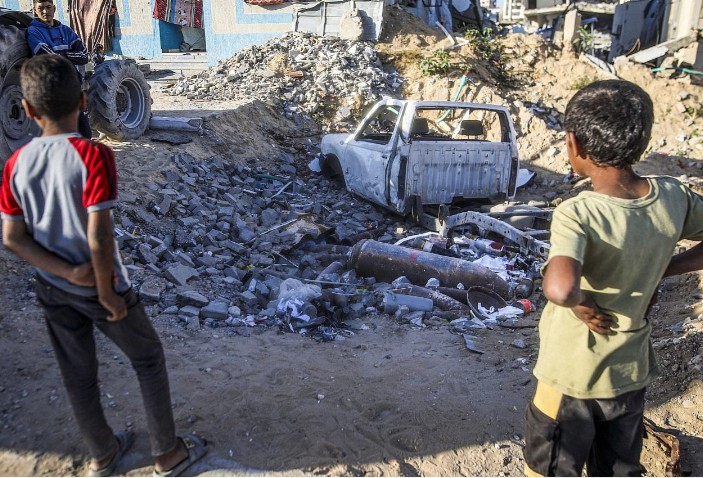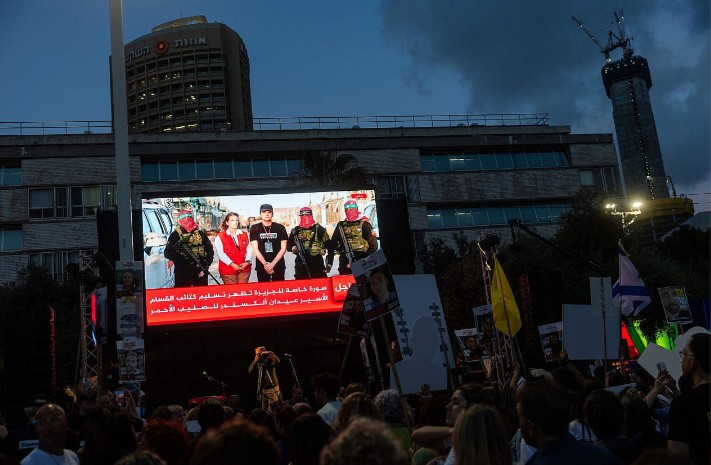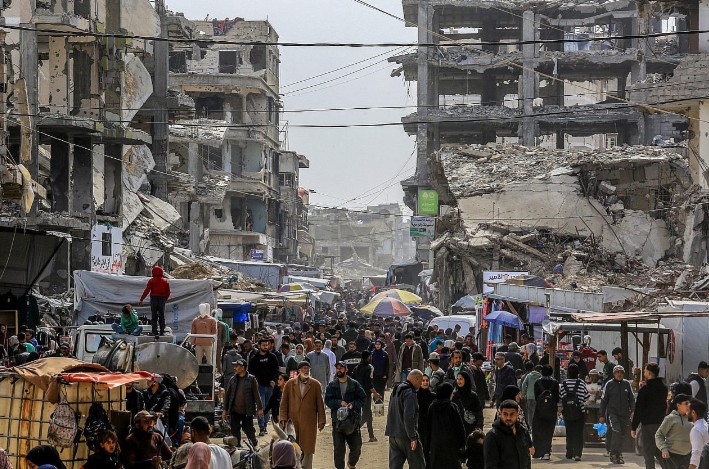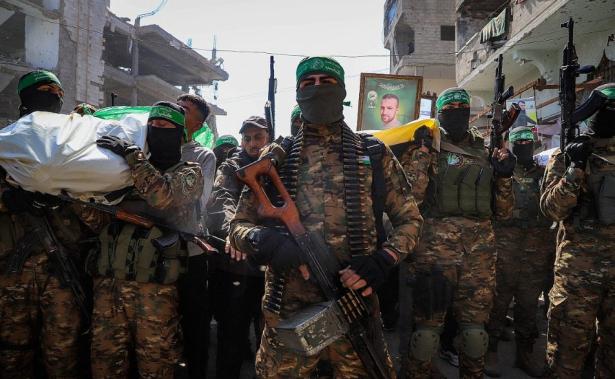In mid-April, Egypt delivered Israel’s latest proposal to Hamas: a temporary, 45-day truce in exchange for the release of 12 Israeli captives and 16 bodies. This time, however, Prime Minister Benjamin Netanyahu added a condition that prompted Hamas to immediately reject the offer — a demand for the group’s complete disarmament, without any commitment to ending the war, withdrawing Israeli forces from Gaza, or halting the ethnic cleansing.
The truth is, Israel’s insistence on Hamas’ disarmament is a red herring designed to sabotage any meaningful progress in the ceasefire talks and allow the genocide to continue. This was made abundantly clear when Israel’s government adopted plans to conquer and permanently occupy all of Gaza, squeeze the population into concentration camps near the border with Egypt and force as many as possible to leave, and maintain that apparatus even after all Israeli captives are released.
Demanding disarmament is a similar sleight of hand to the one that allowed Netanyahu to derail ceasefire negotiations last year by falsely claiming that invading Rafah was crucial to the process of dismantling Hamas’ smuggling tunnels along the Egyptian border. After 12 months of systematically leveling the southern city, Israeli forces failed to uncover a single operational tunnel. Yet as Israel’s own former defense minister recently revealed, that didn’t stop the government from fabricating a tunnel discovery specifically to sabotage ceasefire efforts.
For Israel, Hamas’ disarmament is merely the pretext; The real goal, as Netanyahu himself admitted recently, is to render Gaza uninhabitable, ungovernable, and ultimately unpopulated. Every negotiation Israel sabotages, every ceasefire it undermines, and every humanitarian convoy it blocks are part of a deliberate campaign of ethnic cleansing. Netanyahu’s strategy is not peace through security, but conquest through suffering: to grind Gaza down until its people either flee, starve, or disappear beneath the rubble. This is not a war on Hamas, it is a war on the very existence of Palestinians in Gaza.
An ‘existential threat’ to Israel
After a year and a half of Israeli bombardment and blockade, Hamas has virtually no offensive weaponry left. While the group launched about 5,000 rockets at Israel during its October 7 attack, it is now only capable of firing once or twice a week.
But even these sporadic launches — improvised projectiles without warheads that have not killed a single Israeli since Israel shattered the ceasefire in March — have triggered intense domestic backlash against Hamas. Israel seizes on them as justification for collective punishment, issuing mass expulsion orders and carrying out indiscriminate bombings across the enclave. Netanyahu himself boasted at the UN last October that Hamas had lost over 90% of its rocket stockpile.
The chances of Hamas launching another October 7-style attack in the foreseeable future are conclusively zero. Many analysts agree that what allowed for the assault to succeed was Israel getting caught completely off guard. But that element of surprise is long gone, along with the chances of Israel repeating the same tactical and intelligence failures that allowed it to be attacked in such a way in the first place.

According to officials involved in the negotiations, Hamas leaders in Gaza themselves say they would not fire a single bullet at Israel at least for the next 10-20 years, as long as Israel allows the reconstruction of Gaza to proceed and lifts the siege. The January ceasefire clearly demonstrated this: despite Israel violating the truce nearly 1,000 times, killing over 150 Gazans, and blocking aid, Hamas did not fire a single bullet at Israeli troops or deliberately launch a single rocket at Israel.
But while Hamas no longer maintains the capacity or will to directly threaten Israel itself, it can sustain a long-term insurgency inside Gaza against occupying Israeli forces, fueled by Israel’s continued genocide and blockade. According to Israeli and U.S. intelligence officials, Hamas has managed to recruit at least as many fighters as it lost to Israeli attacks since the start of the war.
Both Israel and Hamas share an interest in exaggerating Hamas’ remaining capabilities. Israel wants to portray Hamas as an “existential threat” to justify its continued onslaught on Gaza, while Hamas wants to present an image of victory in hope of strengthening its position in the ceasefire negotiations, particularly with regard to the withdrawal of Israeli troops. By projecting strength after 18 months of war, Hamas aims to prove to Israelis the futility of their country’s genocidal violence, both in crushing the group itself and Palestinian resistance in general.
The disarmament trap
Right now, about 10,000 tons of unexploded Israeli bombs lie scattered across Gaza, material Hamas recycles into rockets, mortars, and IEDs.
Israel has been preventing UN missions and other international organizations from doing any demining work in Gaza. A senior European Union official told me that Israel only allows UN missions to mark unexploded ordinances with spray paint, leaving them at risk of falling into the hands of Hamas or killing or injuring civilians. Israel has also killed dozens of Gaza’s police engineering division tasked with demining and defusing unexploded ordnance.

The Egyptian Plan for Gaza’s recovery and reconstruction explicitly lays out a plan for the removal and disposal of unexploded ordnance in Gaza within six months. It also proposes ending Hamas’ rule in Gaza where a technocratic administrative committee would take over for a transitional period with a police force that is trained by Egypt and Jordan. Hamas, Fatah, the Palestinian Authority (PA) and the Arab League all endorsed this plan. Israel, however, immediately rejected it.
Hamas reportedly offered Trump’s hostage negotiator, Adam Boehler, a commitment whereby it would not produce any new weapons or dig any new tunnels in return for a long-term truce with Israel. Some Hamas officials have even indicated willingness to “have all of the group’s weapons placed in a guarded warehouse”.
These offers — effectively amounting to a commitment by Hamas to disarm while saving face — would be a win-win. And yet, Israel again rejected them as “non-starter.” In fact, Netanyahu’s government leaked the secret channel between Washington and Hamas to sabotage Boehler’s efforts, before doing everything in its power to remove him from his role altogether.
Over 70 days later, the U.S.-Hamas channel was resumed and the group announced the unconditional release of U.S.-Israeli soldier Edan Alexander as a gesture of good faith toward Trump ahead of his Middle East visit. It was a smart, if belated, move — one that could have been made in early March, when Boehler first engaged with Hamas. The group tried to extract concessions in exchange for Alexander’s release, and by the time they circled back, Netanyahu had already derailed the talks.

Now, with no deal in hand, Hamas hopes the gesture will expose Netanyahu’s intransigence — both to the White House and the Israeli public — and increase pressure to revive ceasefire negotiations, possibly around the Witkoff proposal. But the move could also backfire: Netanyahu is already spinning it as a result of “military pressure,” using it to justify continuing the war. As Trump begins his meetings with regional leaders, the question remains whether this symbolic release opens a diplomatic door — or merely becomes more fodder for a prolonged conflict.
Had Israel allowed Boehler’s meetings to continue, we would have probably gotten a more comprehensive deal out of Alexander’s release that would have included a long term truce with Hamas providing numerous security guarantees that would in practice amount to disarmament.
Why, then, does Netanyahu insist on disarming Hamas at every opportunity, while simultaneously sabotaging any real discussion on disarmament? Simple, it’s another one of his maneuvers — demanding concessions he knows Palestinians can’t and won’t accept, in order to blow up discussions he does not want to hold.
Why doesn’t Hamas just disarm?
Netanyahu’s insistence on Hamas unilaterally disarming is a red line for a number of reasons. First, Israel is giving Hamas no incentive to disarm. Netanyahu made clear that even if the group surrenders, exiles its leaders, and returns all hostages, Israel would still occupy and depopulate Gaza. Israel’s defense minister reiterated this position in mid-April when he said the Israeli army will continue to occupy major chunks of Gaza “in any arrangement — temporary or permanent,” through the creation of so-called “buffer zones,” similar to those Israel previously established in Lebanon and Syria.
That’s why when people ask why Hamas doesn’t surrender like Japan or Germany in 1945, they are missing the point. Aside from Germany and Japan being occupying aggressors, while Palestinians are occupied people resisting domination, neither of those countries faced the threat of settler colonialism or full depopulation as Gaza does today. Moreover, after surrendering, both of these nations received tens of billions of dollars in aid for reconstruction from the very country they surrendered to, while Israel refuses to invest a single penny in Gaza’s recovery and actively blocks Palestinians from rebuilding on their own.

Second, Palestinians have learned through traumatic experience that disarmament, rather than facilitating peace, has only made it easier for Israel to kill, kidnap, and maim them. Soon after the PLO surrendered its weapons in 1982 and left Lebanon, Israel and its South Lebanon Army proxy massacred over 3,500 Palestinian refugees in Sabra and Shatila. The atrocity was so shocking that 400,000 Israelis took to the street in protest, ultimately forcing Defense Minister Ariel Sharon to resign. Today, Israel faces virtually no domestic backlash for its actions in Gaza or the West Bank, no matter how extreme.
Given this history, demands for Gaza to relinquish its few remaining, largely rudimentary weapons evoke existential fears. Many Palestinians worry that Gaza would become a darker mirror of the West Bank, where settlers and soldiers raid, loot, murder, torture, kidnap and sexually assault with full impunity.
Third, even if Hamas agreed to disarm, it is unclear who would enforce the process. Many of its members would likely reject the authority of the political leadership in Doha, denounce them as traitors, and refuse to disarm while Israeli forces remain present. This scenario resembles the experience in Colombia in 2016, where FARC leaders agreed to disarm but lacked the ability to enforce compliance, leading many fighters to join criminal gangs or other militant groups.
Fourth, according to multiple sources familiar with the negotiations, Netanyahu isn’t merely demanding Hamas’ disarmament — he is insisting on a humiliating surrender, including staged spectacles of Hamas leaders publicly handing over their weapons before being exiled from Gaza. However, Hamas’ current role as the dominant resistance force in Gaza allows it to enforce ceasefires and restrain more radical factions such as Palestinian Islamic Jihad and the Mujahideen Brigades. Its complete removal could create a power vacuum, enabling these groups to carry out unpredictable attacks against Israel — potentially escalating violence rather than ending it.
Compare this to the Palestinian Authority’s recent campaign in Jenin against local armed groups that further depleted its dwindling legitimacy. Today, most Palestinians see the PA security forces as little more than collaborators and subcontractors of Israel’s occupation, especially given that decades of security coordination have yielded no tangible benefits to the public, nor any progress towards statehood, no matter what the PA does to prove to Israel that it’s a worthy partner.
Hamas’ stated position that it will disarm and fully dismantle its military wing once Israel ends its occupation of Palestinian territories it occupied in 1967 has been recently reiterated by the group’s current leader, Khalil al-Hayyia. But crucially, disarmament must be the outcome of a peace agreement, not its prerequisite. The Northern Ireland case offers a clear precedent: the IRA’s disarmament unfolded gradually over seven years following the 1998 Good Friday Agreement, not before it.
At a time when Gaza teeters on the edge of societal collapse, a “de-Baathification”-style purge of Hamas risks plunging the territory into deeper chaos and internal strife. As long as Israel’s occupation persists, even if Hamas disappears, someone else will pick up the gun.
[Muhammad Shehada is a Gazan writer and political analyst, a visiting fellow at the European Council on Foreign Relations.]
Our team has been devastated by the horrific events of this latest war. The world is reeling from Israel’s unprecedented onslaught on Gaza, inflicting mass devastation and death upon besieged Palestinians, as well as the atrocious attack and kidnappings by Hamas in Israel on October 7. Our hearts are with all the people and communities facing this violence.
We are in an extraordinarily dangerous era in Israel-Palestine. The bloodshed has reached extreme levels of brutality and threatens to engulf the entire region. Emboldened settlers in the West Bank, backed by the army, are seizing the opportunity to intensify their attacks on Palestinians. The most far-right government in Israel’s history is ramping up its policing of dissent, using the cover of war to silence Palestinian citizens and left-wing Jews who object to its policies.
This escalation has a very clear context, one that +972 has spent the past 14 years covering: Israeli society’s growing racism and militarism, entrenched occupation and apartheid, and a normalized siege on Gaza.
We are well positioned to cover this perilous moment – but we need your help to do it. This terrible period will challenge the humanity of all of those working for a better future in this land. Palestinians and Israelis are already organizing and strategizing to put up the fight of their lives.


Spread the word